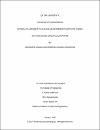Optimal Placement of Phasor Measurement Units for Power Systems Using Genetic Algorithm
| Advisor | Ben-Brahim, Lazhar |
| Advisor | Gastli, Adel |
| Author | Mahgoub, Mohamed Osama |
| Available date | 2017-03-07T10:53:25Z |
| Publication Date | 2017-01 |
| Abstract | Power grids require monitoring to operate with high efficiency while minimizing the chances of having a failure. However, current monitoring scheme which consists of SCADA (Supervisory Control and Data Acquisition), accompanied with conventional meters distributed throughout the grid, is no longer sufficient to maintain an acceptable operation of the grid. This is evident from the multiple failures and blackouts that happened and are still happening in grids worldwide. This issue became more severe due to systems being operated near their limits (to reduce costs and due to the increase in electricity demands), as well as, the addition of renewable energy sources, which usually have abrupt changes. Smart grids were introduced as a solution to this issue by the inclusion of Wide Area Monitoring System (WAMS), which is mainly based on Phasor Measurement Units (PMU), which are measurement devices that provides synchronized time stamped measurements with high sending rate which significantly improves the monitoring of the grid. However, PMUs are relatively expensive (considering both direct and indirect costs incurred). Thus, it is desired to know the minimum number of PMUs required for achieving certain monitoring criteria. Thus, Optimal PMU Placement (OPP) formulates an optimization problem to solve this issue. In the literature of OPP, multiple objectives and constraints are considered, based on desired criteria. In this thesis, a review of OPP is made, followed by the application of selected algorithms (Integer Linear Programming and Genetic Algorithm) on various test systems as a verification and then applying it to Qatar Grid, to compare between different considerations as well as gain insight about the possible PMU placements for Qatar Grid. The contribution of this thesis is introducing a modified fitness function for the Genetic Algorithm that provides more diverse results than previous papers, while incorporating for various considerations like Zero Injection Buses, Conventional Measurements and current branch limit. It also analyzes the results of current branch limit and provides new plots describing their effects. |
| Language | en |
| Subject | Genetic Algorithm Observability Optimal PMU Placement Phasor Measurement Unit Electrical engineering Engineering |
| Type | Master Thesis |
| Department | Electrical Engineering |
Files in this item
This item appears in the following Collection(s)
-
Electrical Engineering [62 items ]


